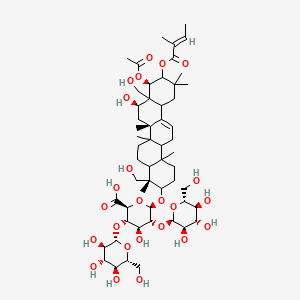Aescin, Aescusan, beta Aescin, beta Escin, beta-Aescin, beta-Escin, Escin, Escina, Eskuzan, Fepalitan, Feparil, Flebostasin, Opino, opino biomo, opino-biomo, opinobiomo, Reparil



| Name | Escin | ||
| PubChem CID | 16211024 | ||
| Molecular Weight | 1131.3g/mol | ||
| Synonyms |
Aescin, Aescusan, beta Aescin, beta Escin, beta-Aescin, beta-Escin, Escin, Escina, Eskuzan, Fepalitan, Feparil, Flebostasin, Opino, opino biomo, opino-biomo, opinobiomo, Reparil |
||
| Formula | C₅₅H₈₆O₂₄ | ||
| SMILES | CC=C(C)C(=O)OC1C(C2(C(CC1(C)C)C3=CCC4C5(CCC(C(C5CCC4(C3(CC2O)C)C)(C)CO)OC6C(C(C(C(O6)C(=O)O)OC7C(C(C(C(O7)CO)O)O)O)O)OC8C(C(C(C(O8)CO)O)O)O)C)CO)OC(=O)C | ||
| InChI | 1S/C55H86O24/c1-10-23(2)46(71)79-43-44(72-24(3)60)55(22-59)26(17-50(43,4)5)25-11-12-30-51(6)15-14-32(52(7,21-58)29(51)13-16-53(30,8)54(25,9)18-31(55)61)75-49-41(77-48-38(67)36(65)34(63)28(20-57)74-48)39(68)40(42(78-49)45(69)70)76-47-37(66)35(64)33(62)27(19-56)73-47/h10-11,26-44,47-49,56-59,61-68H,12-22H2,1-9H3,(H,69,70)/b23-10+/t26?,27-,28-,29?,30?,31-,32?,33-,34-,35+,36+,37-,38-,39+,40+,41-,42+,43?,44+,47+,48-,49-,51?,52-,53?,54-,55?/m1/s1 | ||
| InChIKey | AXNVHPCVMSNXNP-YSYFQUGBSA-N | ||
| CAS Number | 6805-41-0 | ||
| ChEMBL ID | CHEMBL1875956 | ||
| Herb ID | HBIN025744 | ||
| Drug Bank ID | DB15774 | ||
| KEGG ID | C08921 | ||
| Toxicity | Organism | Test Type | Route(Dose) |
| rat | LD50 | intraperitoneal(165 mg/kg) | |
| mouse | LD50 | intraperitoneal(254 mg/kg) | |
| rat | LD50 | oral(322 mg/kg) | |
| Structure | 
|
Download
2D
MOL
3D
MOL
|
|
| Chineses Pinyin | SuoLuoZi | ||
| Use Part | Seed | ||
| Habitat | ZheJiang, JiangSu, HeNan | ||
| Flavor | Sweet | ||
| Meridian Tropism | Liver, Stomach | ||
| Species |
>Kingdom: Viridiplantae
-->Phylum: Streptophyta
-->Class: Equisetopsida
-->Order: Sapindales
-->Family: Sapindaceae
-->Genus: Aesculus
-->Species: Aesculus chinensis
|
||
| Chineses Pinyin | FuPenZi | ||
| Use Part | Aggregate Fruit | ||
| Habitat | AnHui, JiangSu, ZheJiang | ||
| Flavor | Sweet, Sour | ||
| Meridian Tropism | Liver, Kidney, Bladder | ||
| Species |
>Kingdom: Viridiplantae
-->Phylum: Streptophyta
-->Class: Equisetopsida
-->Order: Rosales
-->Family: Rosaceae
-->Genus: Rubus
-->Species: Rubus chingii
|
||
| Chineses Pinyin | QiYeShu | ||
| Use Part | Ripe fruit without shell | ||
| Habitat | HeBei, ShanXi, HeNan, Shaanxi | ||
| Species |
>Kingdom: Viridiplantae
-->Phylum: Streptophyta
-->Class: Equisetopsida
-->Order: Sapindales
-->Family: Sapindaceae
-->Genus: Aesculus
-->Species: Aesculus chinensis
|
||
| Pair Name | Escin, Cisplatin | |||
| Partner Name | Cisplatin | |||
| Disease Info | [ICD-11: 2C60] | Breast cancer | Investigative | |
| Biological Phenomena | Induction-->Ferroptosis | |||
| Gene Regulation | Down-regulation | Expression | GPX4 | hsa2879 |
| Down-regulation | Expression | G6PD | hsa2539 | |
| In Vitro Model | MCF-7 | Invasive breast carcinoma of no special type | Homo sapiens (Human) | CVCL_0031 |
| MDA-MB-231 | Breast adenocarcinoma | Homo sapiens (Human) | CVCL_0062 | |
| In Vivo Model | MDA-MB-231 cells (2.5×10⁶ cells per mouse) stably expressing sh-NC and sh-G6PD were established.When the tumor grew to approximately 60 mm3, 2 mg/kg Escin was intraperitoneally injected with normal saline as the control. | |||
| Result | Role of Escin in breast cancer therapy: potential mechanism for inducing ferroptosis and synergistic antitumor activity with cisplatin | |||
| Pair Name | Escin, Sorafenib | |||
| Partner Name | Sorafenib | |||
| Disease Info | [ICD-11: 2C12] | Hepatocellular carcinoma | Investigative | |
| Biological Phenomena | Induction-->Blockade of cell cycle in G0/G1 phase | |||
| Gene Regulation | Up-regulation | Expression | BECN1 | hsa8678 |
| Up-regulation | Expression | SQSTM1 | hsa8878 | |
| Up-regulation | Expression | MAP1LC3B | hsa81631 | |
| In Vitro Model | Hep-G2 | Hepatoblastoma | Homo sapiens (Human) | CVCL_0027 |
| In Vivo Model | For the following 4 weeks, the animalsreceived daily treatments of water/saline as vehicle, sorafenib (10 mg/kgbw, oral) and escin (10 mg/kg bw, i.p.) alone and also in combination. | |||
| Result | Escin and sorafenib combination potentially up-regulates p62 to block autophagy to induce late apoptosis in liver cancer cells. | |||
| Pair Name | Escin, Sorafenib | |||
| Partner Name | Sorafenib | |||
| Disease Info | [ICD-11: 2C25.Z] | Lung cancer | Investigative | |
| Biological Phenomena | Induction-->Blockade of cell cycle in G0/G1 phase | |||
| Gene Regulation | Up-regulation | Expression | SQSTM1 | hsa8878 |
| Up-regulation | Expression | MAP1LC3B | hsa81631 | |
| Down-regulation | Expression | ATG5 | hsa9474 | |
| In Vitro Model | A-549 | Lung adenocarcinoma | Homo sapiens (Human) | CVCL_0023 |
| NCI-H460 | Lung large cell carcinoma | Homo sapiens (Human) | CVCL_0459 | |
| In Vivo Model | Wistar rats, aged between 6 and 8 weeks, weighing 150–200 g (male),were uesd in study. | |||
| Result | This combination also selectively targeted G0/G1 phase of cancer cells. In in vivo study, the combination reduced tumour load and lower elevated serum biochemical parameters. The combination of sorafenib/escin synergistically inhibits autophagy to induce late apoptosis in lung cancer cells' G0/G1 phase. | |||
| Pair Name | Escin, Ribociclib | |||
| Partner Name | Ribociclib | |||
| Result | Neutropenia | |||
| No. | Title | Href |
|---|---|---|
| 1 | Toxicity Derived from Interaction between Natural Compounds and Cancer Therapeutic Drugs Metabolized by CYP3A4: Lessons Learned from Two Clinical Case Reports. Int J Mol Sci. 2023;24(21):15976. Published 2023 Nov 5. doi:10.3390/ijms242115976 | Click |
| 2 | Escin enhanced the efficacy of sorafenib by autophagy-mediated apoptosis in lung cancer cells. Phytother Res. 2023 Oct;37(10):4819-4837. doi: 10.1002/ptr.7948. | Click |
| 3 | Role of Escin in breast cancer therapy: potential mechanism for inducing ferroptosis and synergistic antitumor activity with cisplatin. Apoptosis. 2023 Aug;28(7-8):1154-1167. doi: 10.1007/s10495-023-01849-x. | Click |
| 4 | Escin-sorafenib synergy up-regulates LC3-II and p62 to induce apoptosis in hepatocellular carcinoma cells. Environ Toxicol. 2024 Feb;39(2):840-856. doi: 10.1002/tox.23988. | Click |
